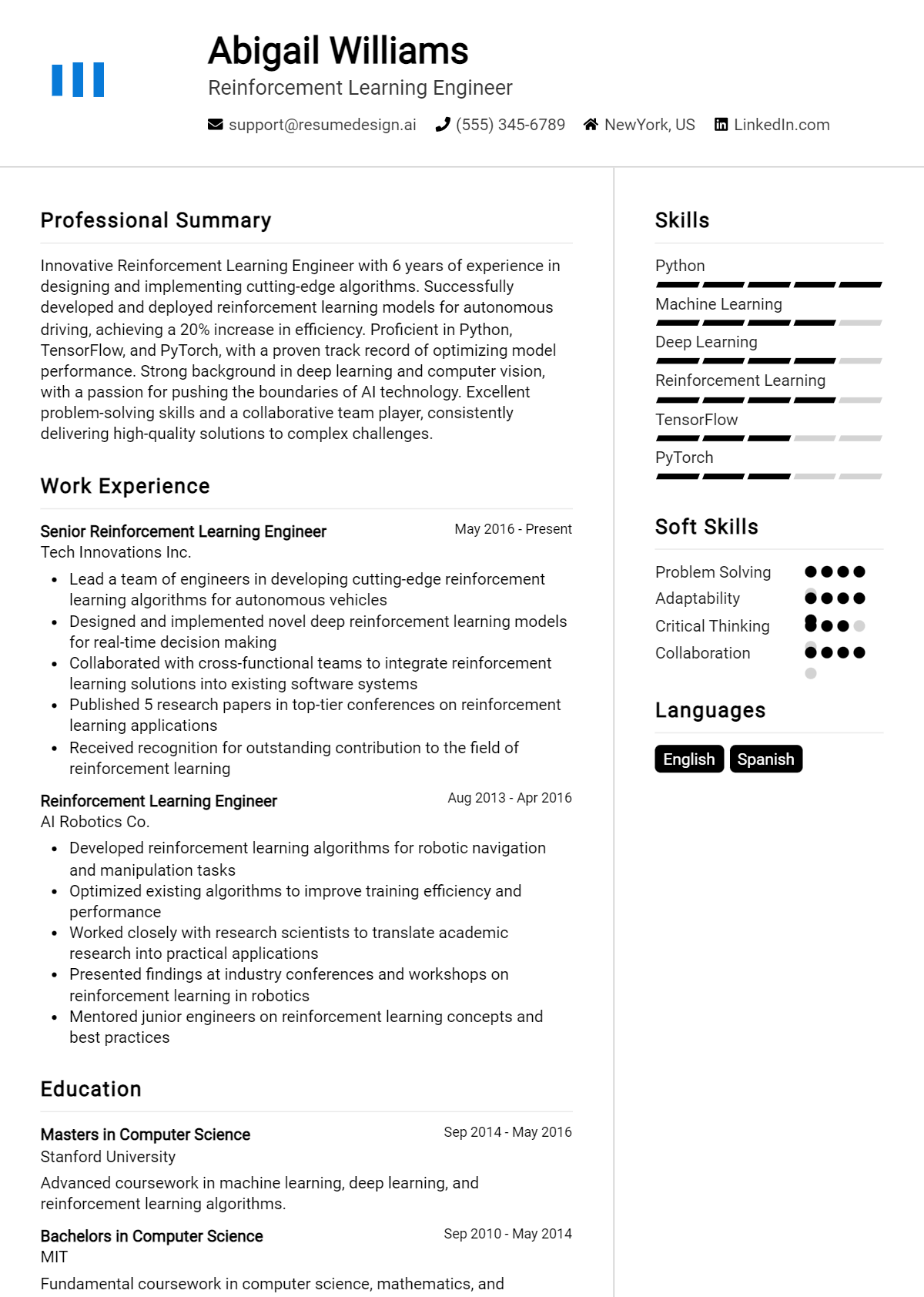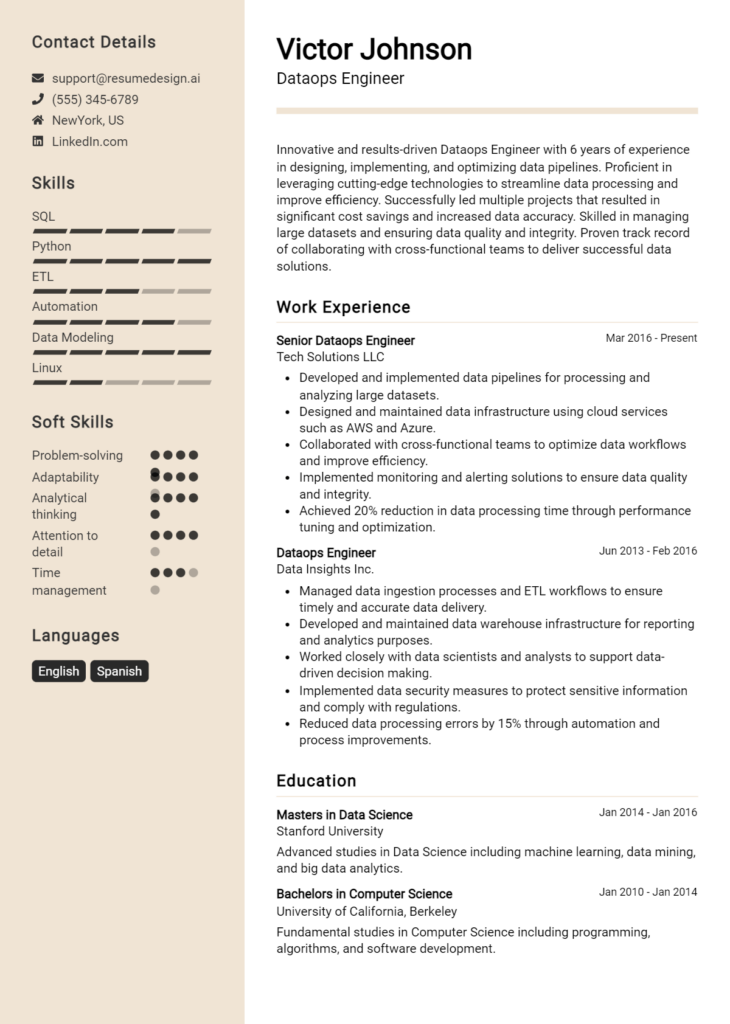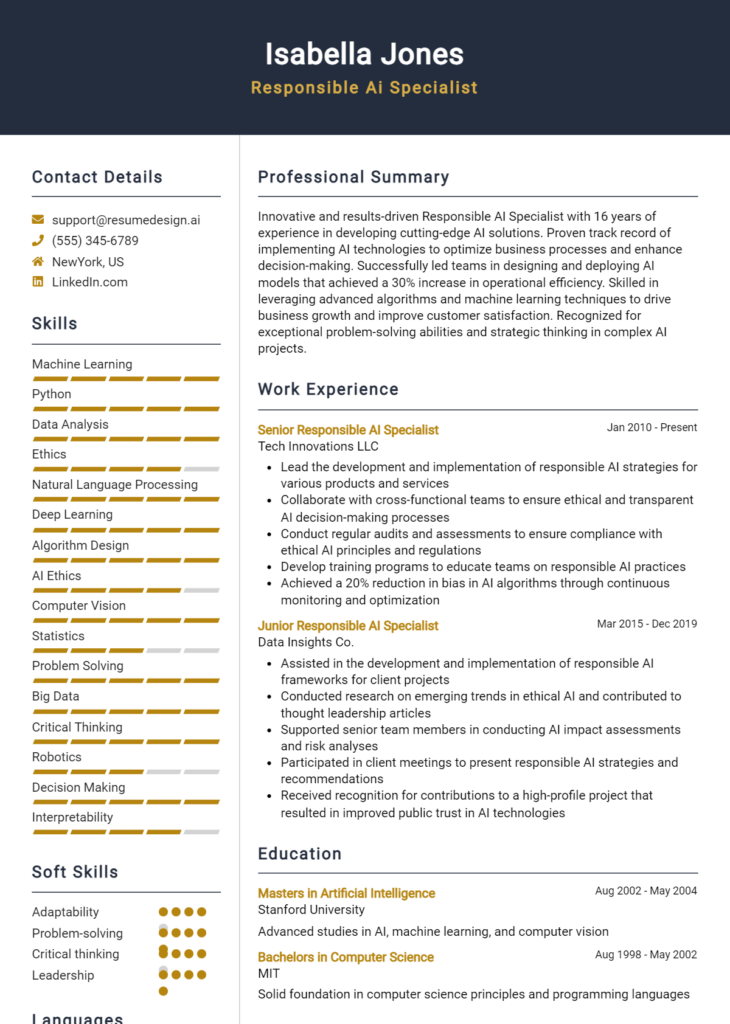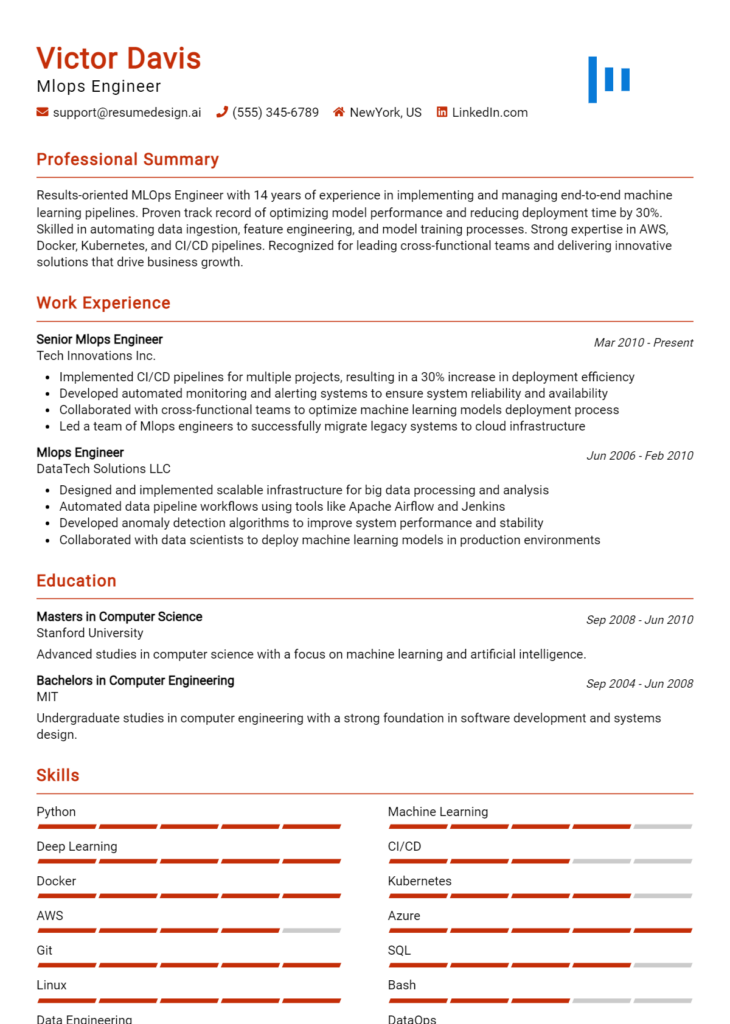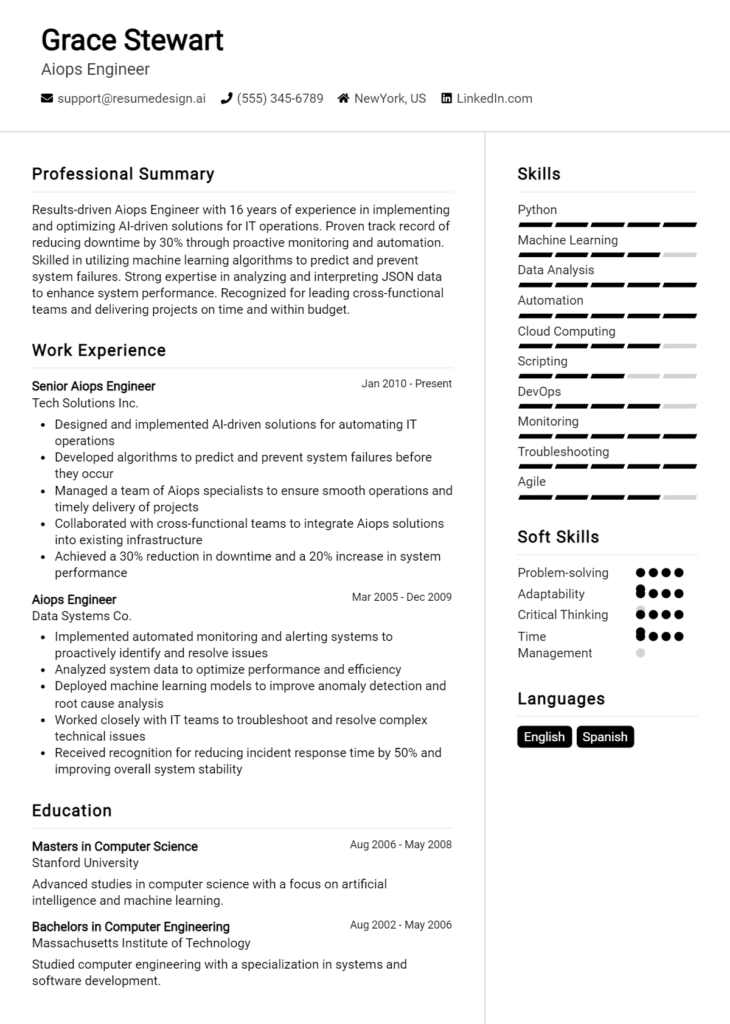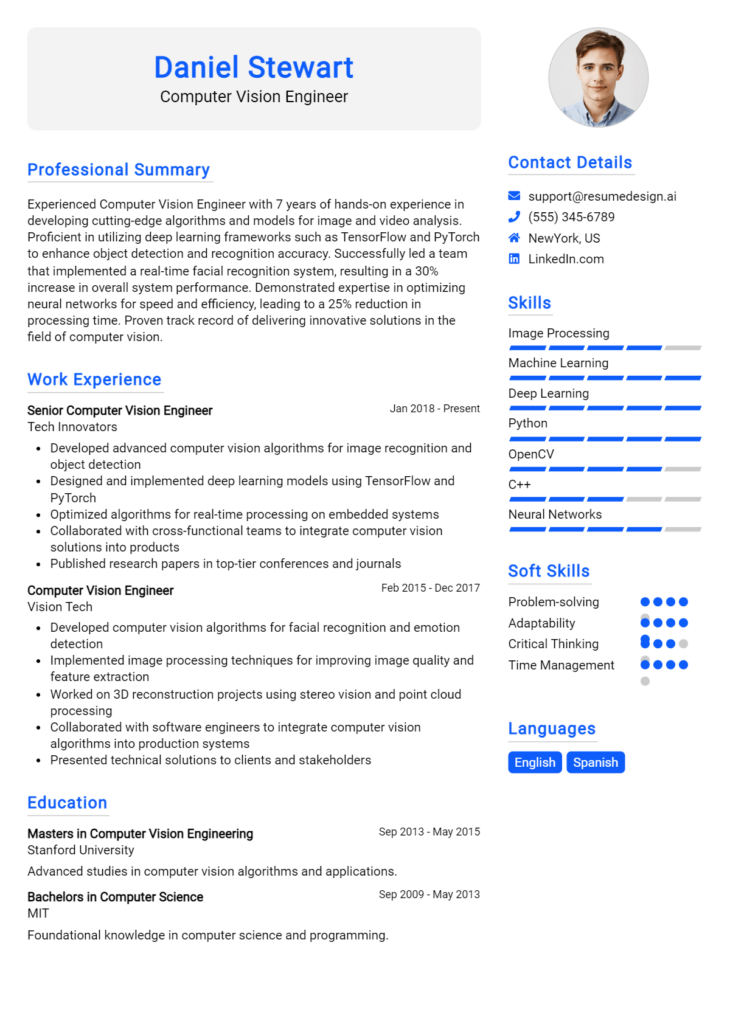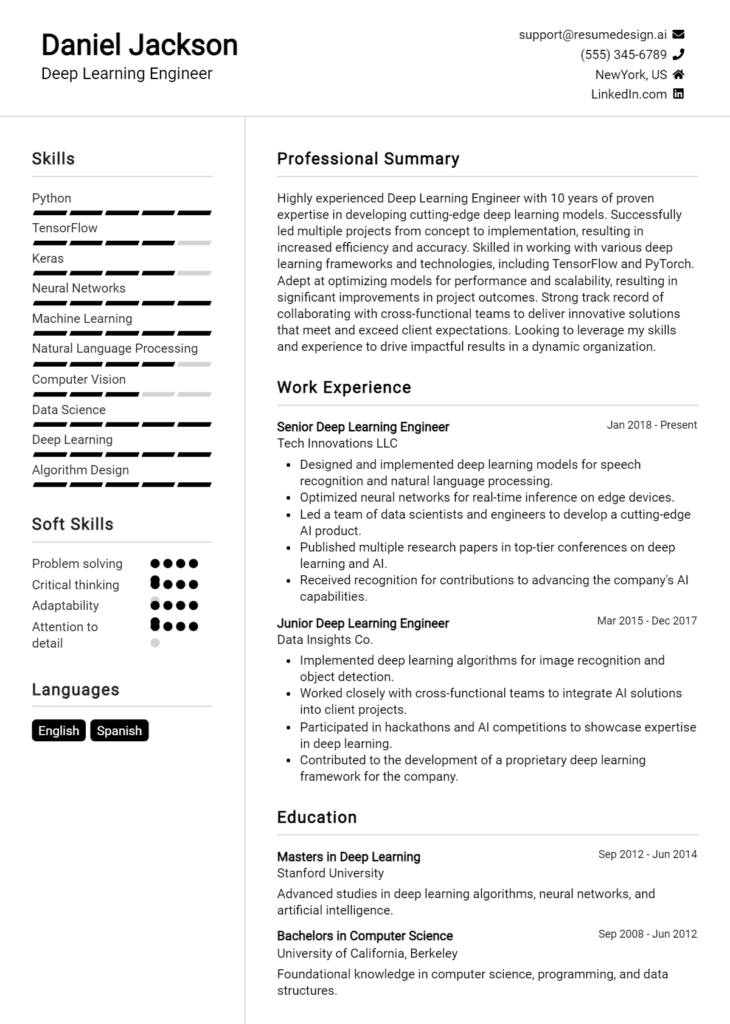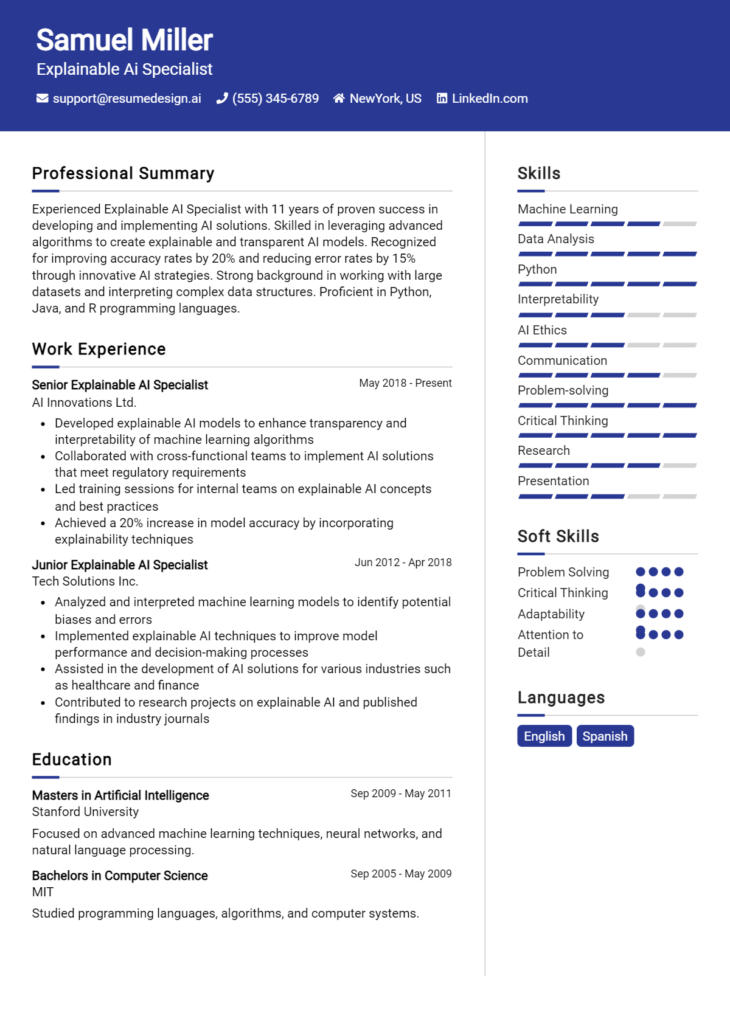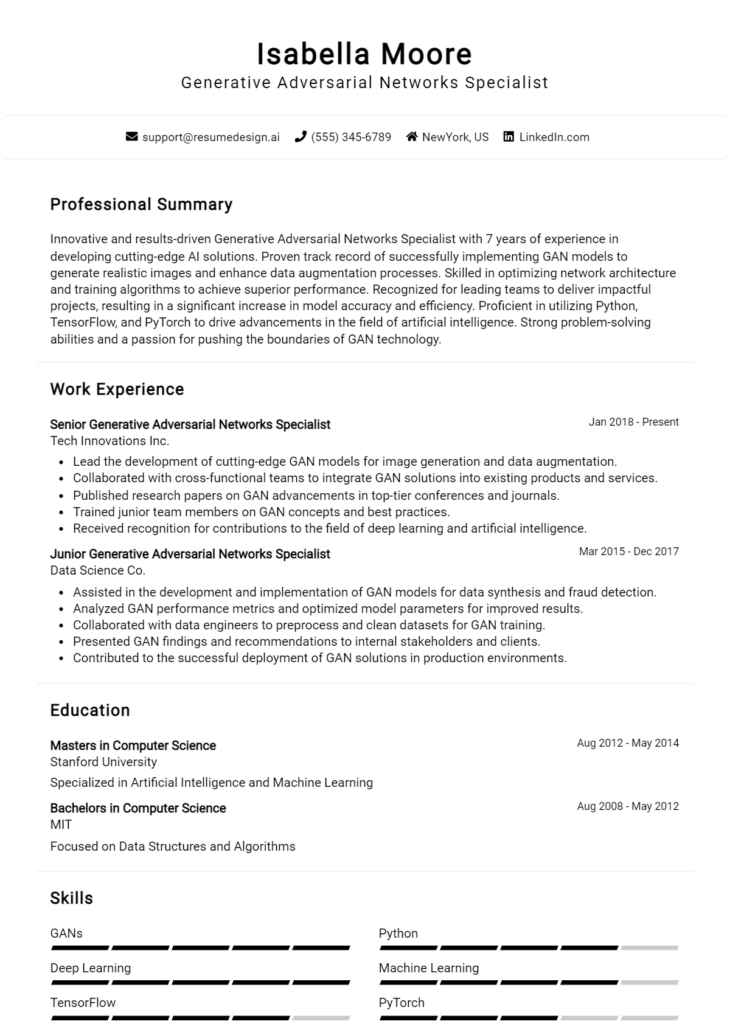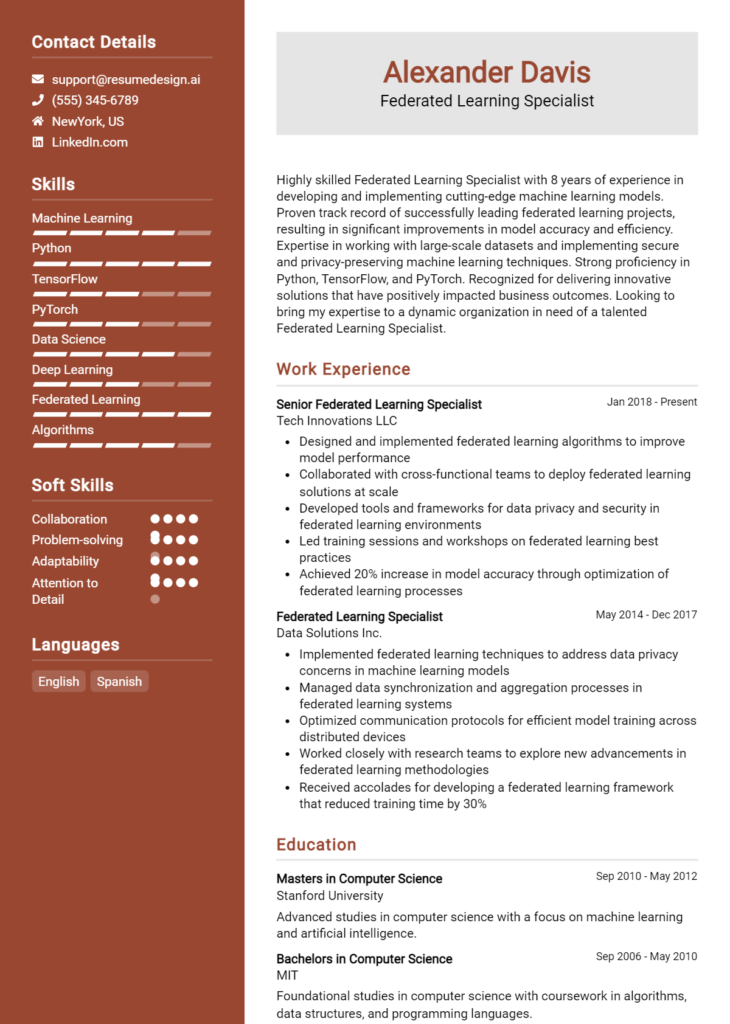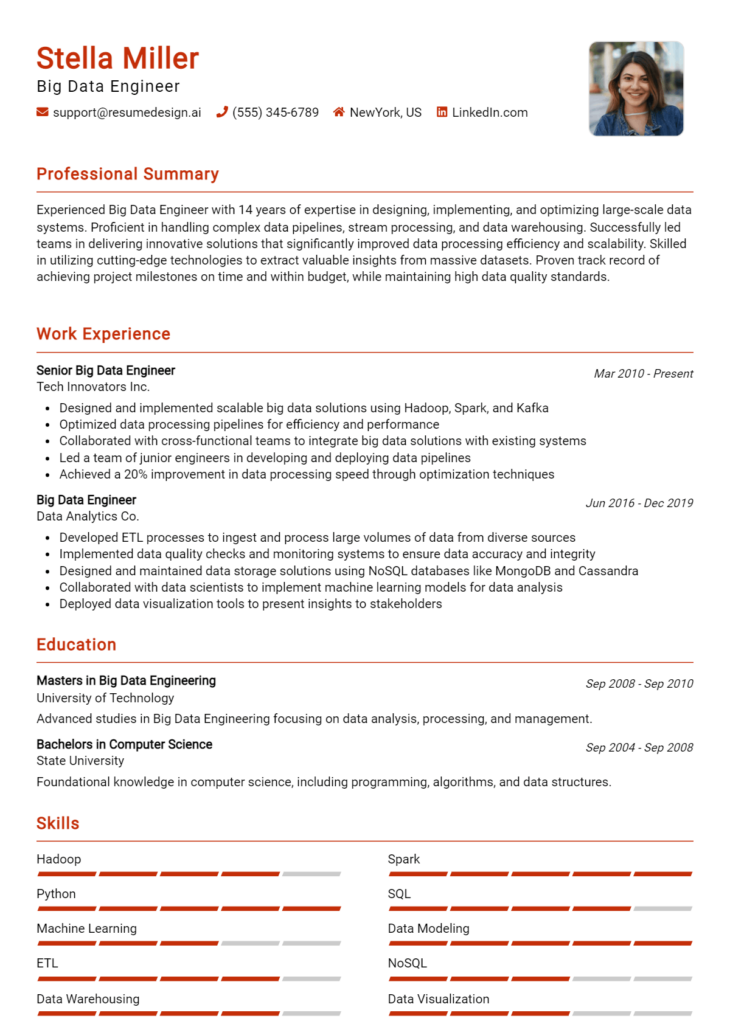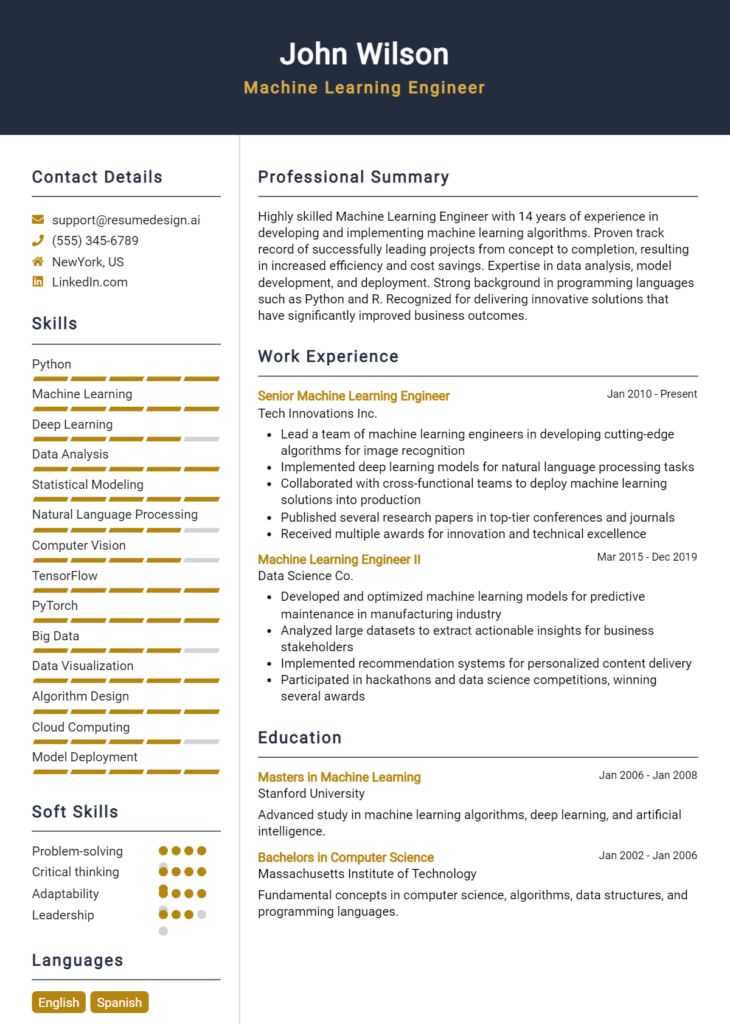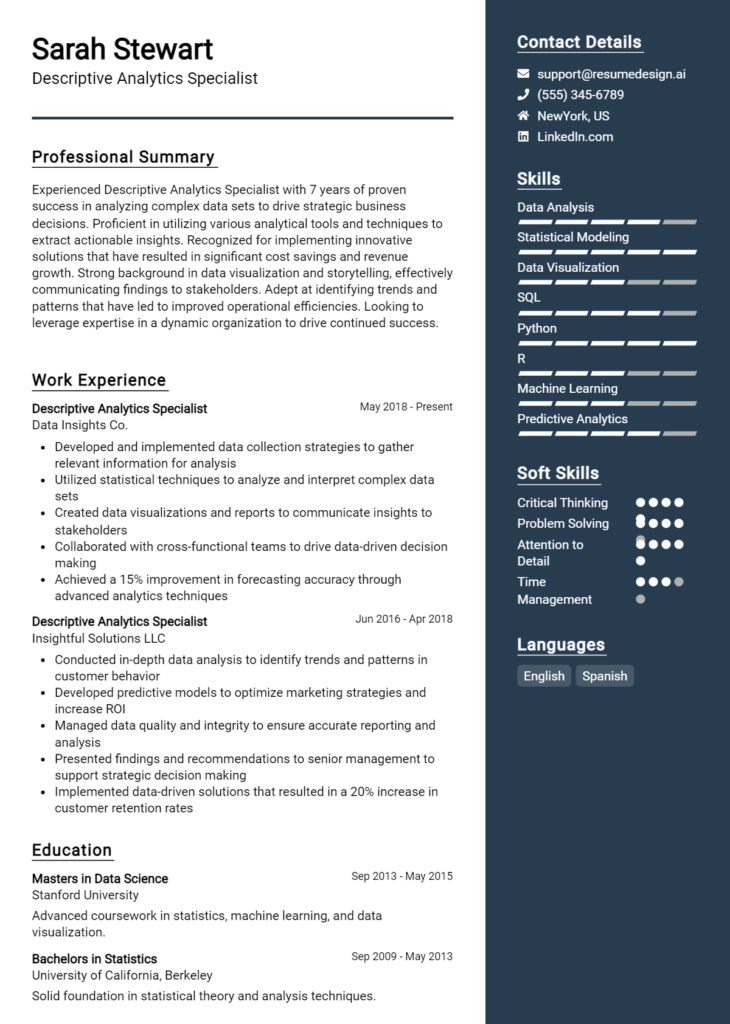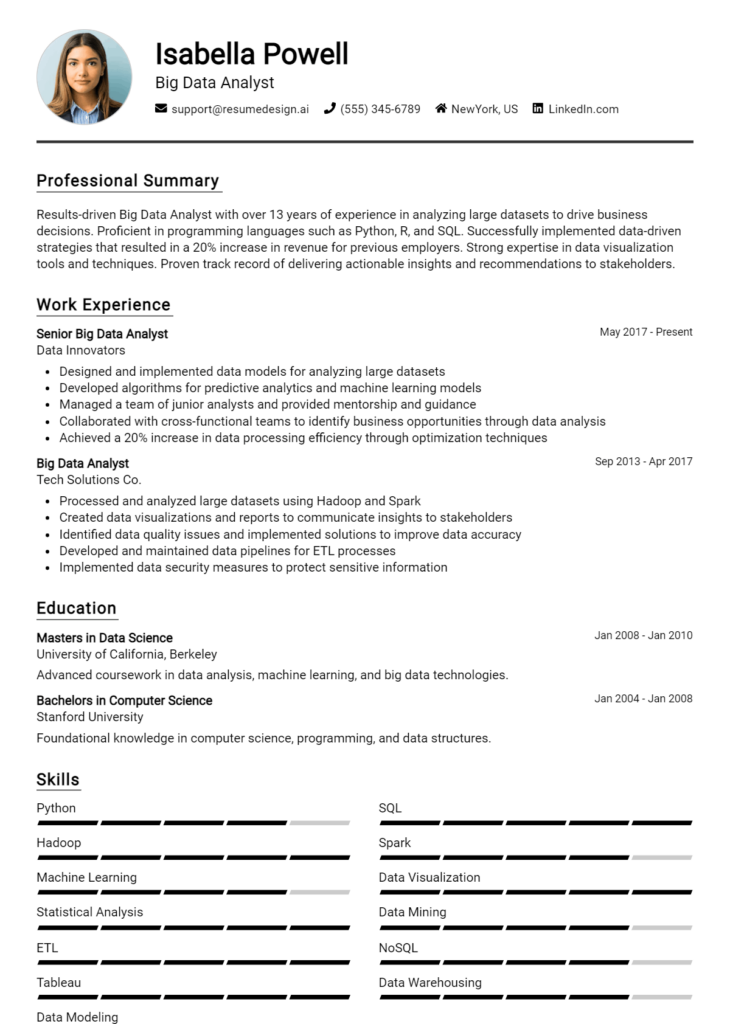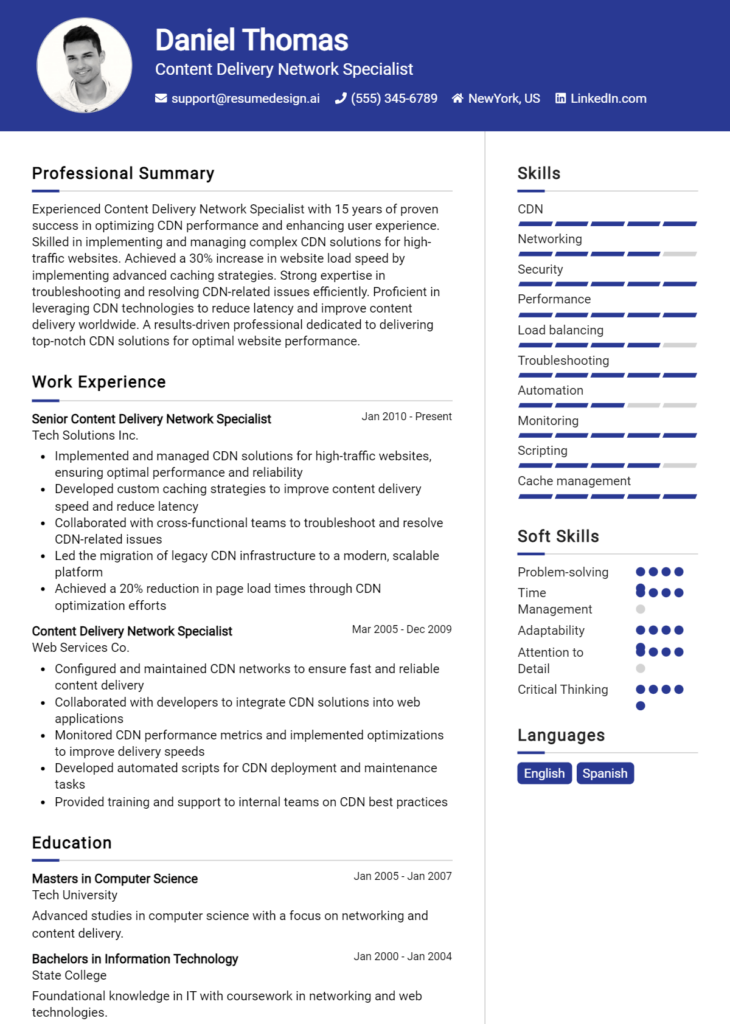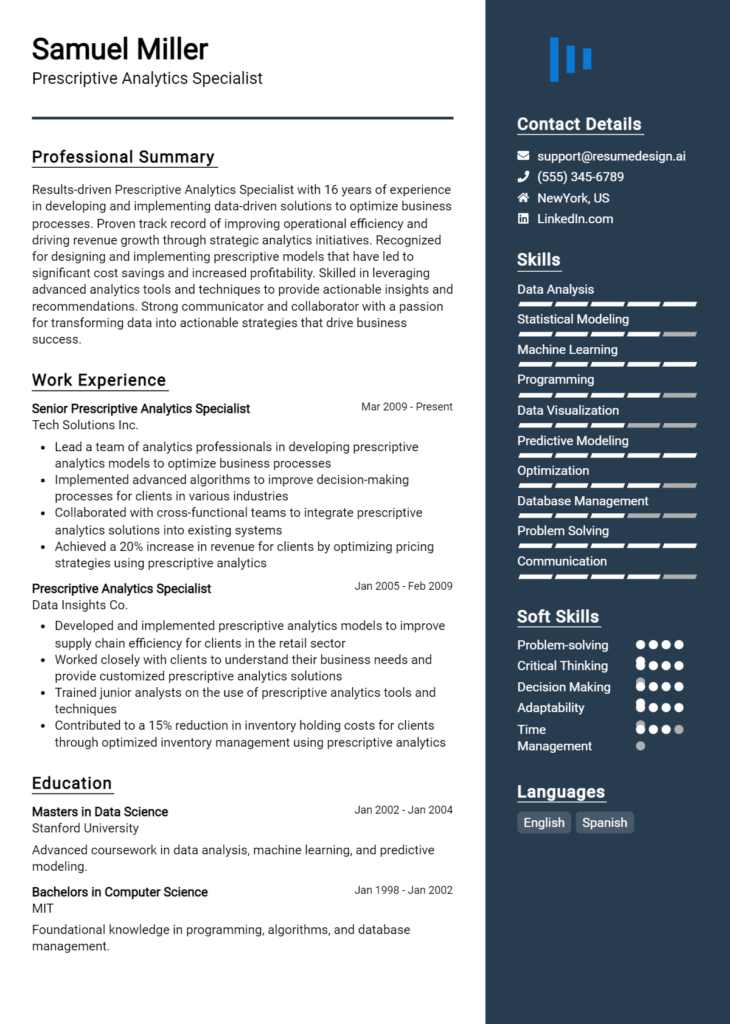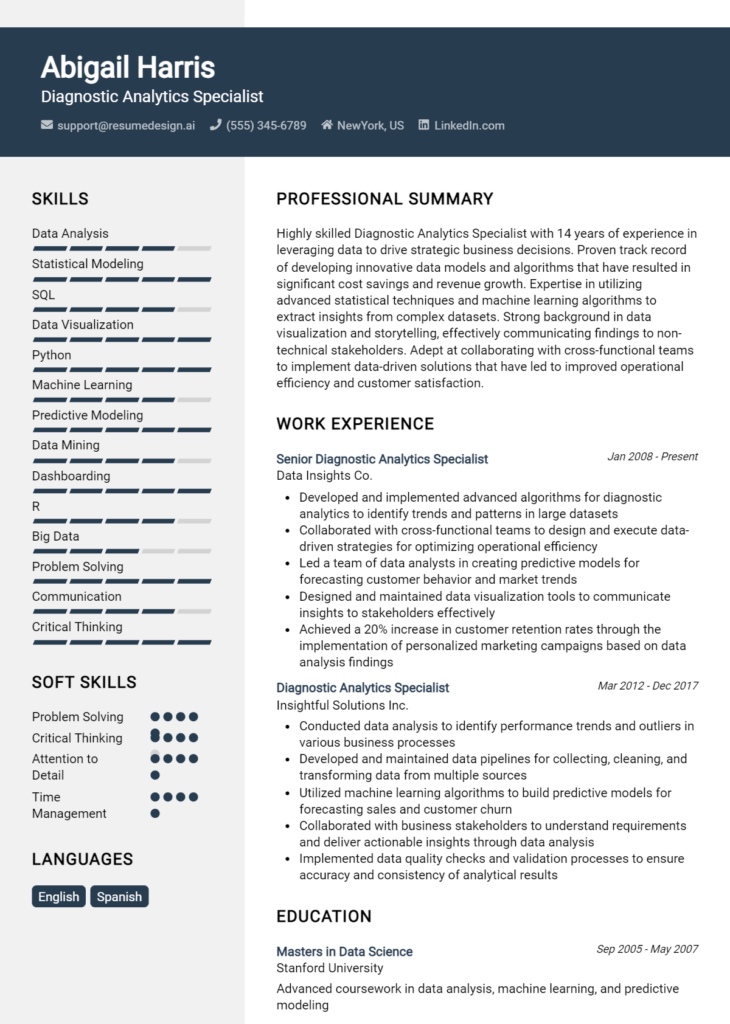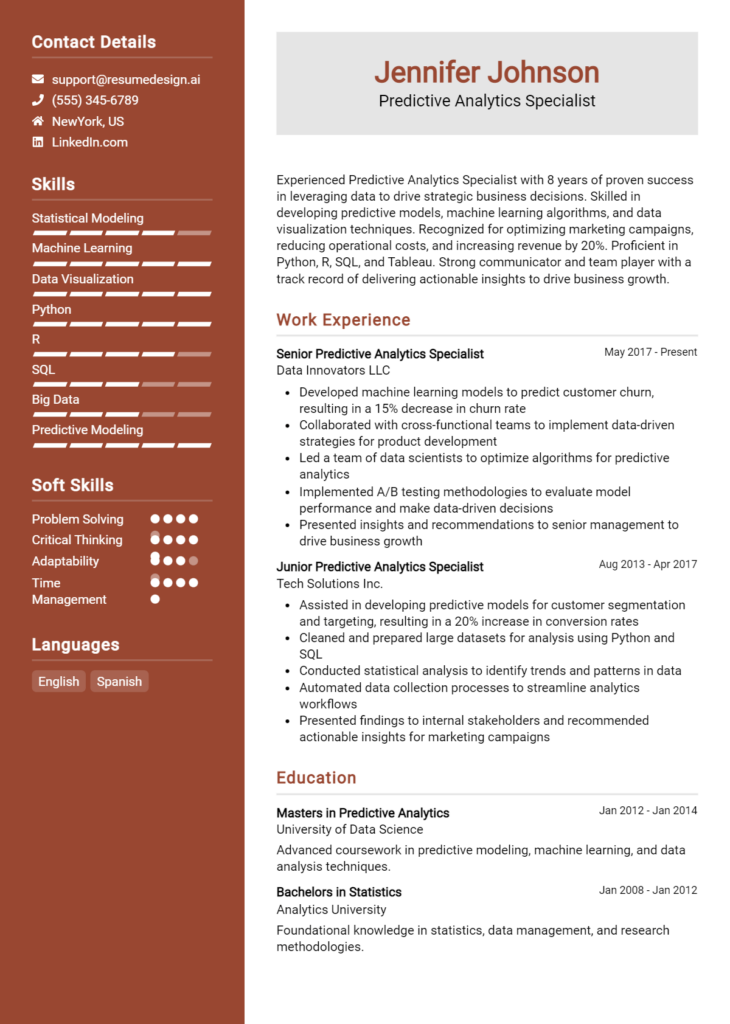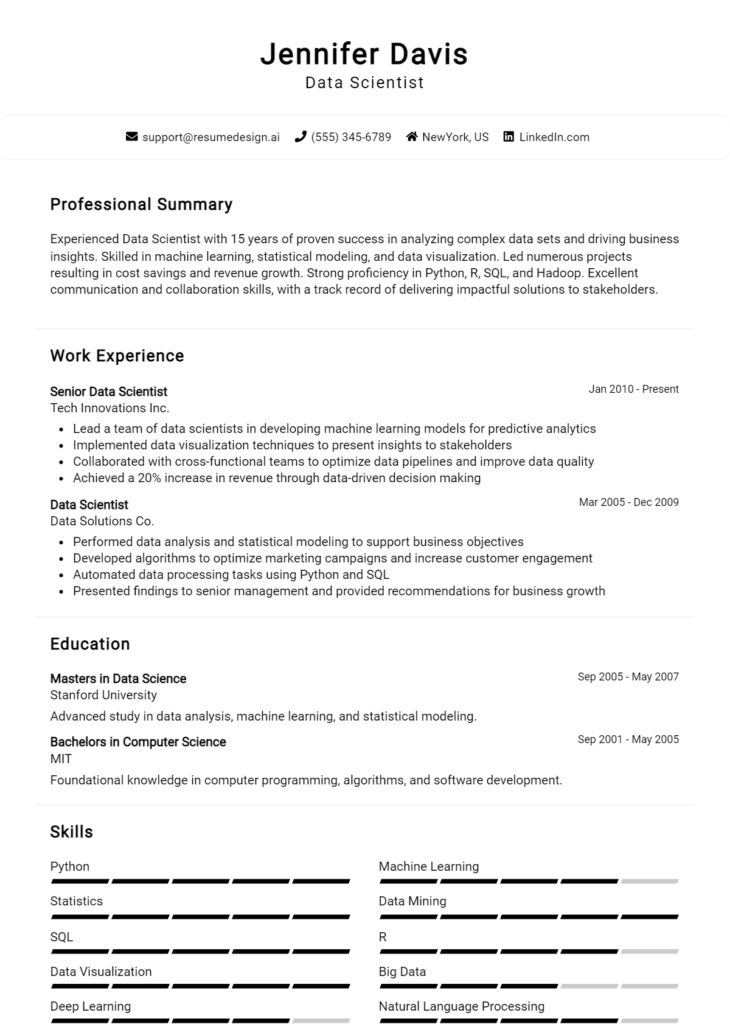Reinforcement Learning Engineer Core Responsibilities
A Reinforcement Learning Engineer plays a pivotal role in developing and implementing algorithms that allow machines to learn from their environments through trial and error. This position requires a deep understanding of machine learning principles, programming expertise, and strong problem-solving skills to optimize models and enhance performance across various applications. By collaborating with data scientists, software engineers, and product teams, they ensure that AI solutions align with organizational goals. A well-structured resume highlighting these technical and operational abilities can effectively demonstrate a candidate's potential impact within the company.
Common Responsibilities Listed on Reinforcement Learning Engineer Resume
- Design and implement reinforcement learning algorithms and models.
- Collaborate with cross-functional teams to integrate machine learning solutions.
- Analyze and preprocess data to improve model performance.
- Conduct experiments to evaluate and fine-tune algorithms.
- Develop simulation environments for testing reinforcement learning strategies.
- Monitor and maintain deployed models for ongoing performance optimization.
- Document processes and results to facilitate knowledge sharing.
- Stay updated with the latest research and advancements in reinforcement learning.
- Utilize programming languages such as Python and frameworks like TensorFlow or PyTorch.
- Engage in continuous learning and professional development in AI technologies.
- Communicate findings and insights to non-technical stakeholders.
High-Level Resume Tips for Reinforcement Learning Engineer Professionals
In the rapidly evolving field of artificial intelligence, a well-crafted resume is crucial for Reinforcement Learning Engineer professionals seeking to make a significant impact in their careers. As the first impression a candidate makes on a potential employer, a resume must not only reflect technical skills and knowledge but also highlight relevant achievements and contributions in the field. It serves as a marketing tool that showcases an individual's unique value proposition in a competitive job market. This guide will provide practical and actionable resume tips specifically tailored for Reinforcement Learning Engineer professionals, helping you stand out and advance your career.
Top Resume Tips for Reinforcement Learning Engineer Professionals
- Tailor your resume to match the specific job description, emphasizing relevant skills and experiences that align with the role.
- Highlight your experience with popular reinforcement learning frameworks such as TensorFlow, PyTorch, or OpenAI Gym.
- Showcase projects that demonstrate your ability to apply reinforcement learning algorithms to real-world problems.
- Quantify your achievements with metrics where possible, such as improvements in model performance or efficiency gains.
- Incorporate industry-specific terminology and keywords to pass through Applicant Tracking Systems (ATS).
- Include a dedicated section for technical skills, highlighting programming languages (e.g., Python, C++) and tools relevant to reinforcement learning.
- List any relevant certifications or courses, such as those from Coursera or Udacity, that pertain to machine learning and reinforcement learning.
- Demonstrate your problem-solving capabilities by including examples of challenges you've overcome in past projects.
- Make sure to present your work experience in reverse chronological order to emphasize your most recent and relevant positions.
By implementing these tips, Reinforcement Learning Engineer professionals can significantly increase their chances of landing a job in this dynamic field. A well-structured resume that highlights tailored skills, relevant experience, and quantifiable achievements will not only capture the attention of hiring managers but also set you apart as a strong candidate ready to tackle complex challenges in reinforcement learning.
Why Resume Headlines & Titles are Important for Reinforcement Learning Engineer
In the highly competitive field of reinforcement learning, a well-crafted resume headline or title serves as a crucial first impression for candidates. It is the first thing hiring managers see and can significantly influence their decision to delve deeper into a resume. A strong headline succinctly summarizes a candidate's key qualifications, skills, or achievements in a manner that is both relevant and compelling. By capturing attention quickly, it sets the tone for the rest of the resume, making it essential for candidates to reflect their expertise in reinforcement learning in a concise and impactful phrase.
Best Practices for Crafting Resume Headlines for Reinforcement Learning Engineer
- Make it concise: Aim for one impactful sentence or phrase.
- Be role-specific: Tailor the headline to reflect the position of a Reinforcement Learning Engineer.
- Highlight key skills: Focus on critical competencies in reinforcement learning and AI.
- Use action-oriented language: Begin with strong verbs that convey expertise and capability.
- Incorporate quantifiable achievements: If possible, mention specific accomplishments relevant to the field.
- Stay relevant: Ensure the headline aligns with the job description and requirements.
- Avoid jargon: Use clear language that is easily understood by hiring managers.
- Showcase unique value: Highlight what sets you apart from other candidates.
Example Resume Headlines for Reinforcement Learning Engineer
Strong Resume Headlines
Innovative Reinforcement Learning Engineer with 5 Years of Experience in Developing Scalable AI Solutions
Data-Driven Reinforcement Learning Specialist with Proven Success in Optimizing Complex Algorithms
Award-Winning Machine Learning Engineer Focused on Reinforcement Learning Applications in Robotics
Weak Resume Headlines
Engineer with Experience
Reinforcement Learning Enthusiast
The strong headlines are effective because they immediately communicate specific expertise and accomplishments relevant to the role of a Reinforcement Learning Engineer, thus establishing credibility and interest. In contrast, the weak headlines fail to impress as they lack specificity and do not highlight unique qualifications, leaving hiring managers with little incentive to explore further. A well-crafted headline sets the stage for a powerful resume, while a vague one can quickly lead to dismissal.
Writing an Exceptional Reinforcement Learning Engineer Resume Summary
A well-crafted resume summary is critical for a Reinforcement Learning Engineer as it serves as the first impression a candidate makes on hiring managers. This brief yet powerful section encapsulates key skills, relevant experience, and notable accomplishments that align with the job role. An effective summary not only captures attention quickly but also sets the tone for the rest of the resume, enticing recruiters to delve deeper into the candidate's qualifications. It should be concise, impactful, and tailored specifically to the job description, ensuring that the candidate stands out in a competitive field.
Best Practices for Writing a Reinforcement Learning Engineer Resume Summary
- Quantify achievements: Use numbers and metrics to demonstrate the impact of your work.
- Focus on key skills: Highlight technical skills relevant to reinforcement learning, such as algorithms, programming languages, and tools.
- Tailor to the job description: Customize your summary to reflect the specific requirements and responsibilities of the position you’re applying for.
- Use action-oriented language: Start sentences with strong action verbs to convey your contributions effectively.
- Showcase relevant experience: Include specific projects or areas of expertise that relate directly to reinforcement learning.
- Keep it concise: Aim for 3-5 sentences that encapsulate your qualifications without excessive detail.
- Highlight collaboration: Mention teamwork or interdisciplinary projects, as collaboration is often key in AI and machine learning roles.
- Include certifications or advanced degrees: If applicable, highlight any relevant certifications or educational credentials that enhance your qualifications.
Example Reinforcement Learning Engineer Resume Summaries
Strong Resume Summaries
Innovative Reinforcement Learning Engineer with 5+ years of experience in developing scalable algorithms that improved model accuracy by 30%. Proficient in Python and TensorFlow, with a strong foundation in neural networks and deep learning. Successfully led a team project that reduced training time by 25% through optimized data preprocessing techniques.
Results-driven ML Engineer specializing in reinforcement learning and natural language processing. Developed and deployed an autonomous agent that outperformed benchmarks by 40% in simulated environments. Experience in collaborating with cross-functional teams to integrate AI solutions into existing products, enhancing user engagement by 15%.
Detail-oriented Reinforcement Learning Engineer skilled in implementing advanced algorithms and simulations. Achieved a 50% reduction in error rates in predictive models through rigorous testing and validation. Holds a Master’s in Machine Learning and certified in TensorFlow.
Weak Resume Summaries
Experienced engineer with a background in machine learning. I have worked on various projects but I am looking for new opportunities in reinforcement learning.
A motivated professional with skills in AI. Interested in working with teams and learning more about reinforcement learning.
The strong resume summaries stand out because they provide quantifiable results, specific technical skills, and a clear demonstration of relevant experience. They convey a candidate's value succinctly, making a compelling case for their candidacy. In contrast, the weak resume summaries lack detail and clarity, failing to highlight any significant achievements or relevant skills. This vagueness diminishes their impact and makes it difficult for hiring managers to assess the candidate's qualifications effectively.
Work Experience Section for Reinforcement Learning Engineer Resume
The work experience section is a critical component of a Reinforcement Learning Engineer resume, as it provides potential employers with a clear view of a candidate's technical skills and their capability to manage teams while delivering high-quality products. This section not only highlights the candidate's relevant experience in reinforcement learning algorithms, machine learning frameworks, and software development but also emphasizes their ability to achieve measurable results. Quantifying achievements and aligning experiences with industry standards are essential to help illustrate the candidate’s impact on previous projects and their readiness to contribute to future endeavors.
Best Practices for Reinforcement Learning Engineer Work Experience
- Detail specific reinforcement learning projects, including the algorithms and technologies used.
- Quantify results with metrics such as performance improvements, efficiency gains, or successful deployment outcomes.
- Highlight leadership roles in team projects, focusing on collaboration and mentorship.
- Include relevant programming languages and tools, demonstrating technical proficiency.
- Showcase problem-solving skills by detailing challenges faced and solutions implemented.
- Align experiences with industry standards and trends to demonstrate awareness of current practices.
- Use action verbs to convey a strong sense of initiative and responsibility.
- Tailor your experiences to the job description, ensuring relevance to the prospective employer’s needs.
Example Work Experiences for Reinforcement Learning Engineer
Strong Experiences
- Led a team of 5 engineers to develop a reinforcement learning model that improved recommendation accuracy by 30%, resulting in a 15% increase in user engagement over 6 months.
- Designed and implemented a real-time adaptive learning system using TensorFlow and PyTorch, successfully reducing training time by 40% while maintaining model performance.
- Collaborated with cross-functional teams to integrate reinforcement learning solutions into existing platforms, enhancing system efficiency by 25% and reducing operational costs.
Weak Experiences
- Worked on machine learning projects as part of a team.
- Used various algorithms for data analysis.
- Participated in meetings to discuss project progress.
The examples provided illustrate a stark contrast between strong and weak experiences. Strong experiences are characterized by specific achievements, quantifiable outcomes, and clear contributions to team efforts that demonstrate both leadership and technical expertise. In contrast, weak experiences lack detail and fail to convey significant impact, making it difficult for potential employers to grasp the candidate's capabilities and contributions. Highlighting concrete results and responsibilities is essential to stand out in a competitive job market.
Education and Certifications Section for Reinforcement Learning Engineer Resume
The education and certifications section of a Reinforcement Learning Engineer resume plays a crucial role in establishing the candidate's qualifications and expertise in the field. This section showcases the academic background, relevant certifications, and commitment to continuous learning that are essential for a role focused on complex algorithms and machine learning techniques. By including pertinent coursework, industry-recognized certifications, and specialized training, candidates can significantly enhance their credibility and demonstrate their alignment with the job requirements, making a compelling case for their capabilities in reinforcement learning applications.
Best Practices for Reinforcement Learning Engineer Education and Certifications
- Include degrees in relevant fields such as Computer Science, Data Science, or Artificial Intelligence.
- List industry-recognized certifications such as those from Coursera, edX, or specialized AI/ML programs.
- Highlight relevant coursework, such as Machine Learning, Deep Learning, and Reinforcement Learning.
- Provide details about any research projects or thesis work related to reinforcement learning.
- Update the section regularly with new certifications or courses completed to reflect continuous learning.
- Use clear formatting to make the information easy to read and understand.
- Be specific about the institutions and dates of completion for credibility.
- Include any relevant workshops, seminars, or conferences attended that are related to reinforcement learning.
Example Education and Certifications for Reinforcement Learning Engineer
Strong Examples
- M.S. in Computer Science, specializing in Artificial Intelligence, Stanford University, 2022
- Deep Reinforcement Learning Specialization, Coursera, 2023
- Ph.D. Thesis: "Advancements in Policy Gradient Methods for Reinforcement Learning," University of California, Berkeley, 2023
- Certified TensorFlow Developer, Google, 2022
Weak Examples
- B.A. in History, University of Texas, 2010
- Certified Microsoft Office Specialist, 2019
- Online Course in Basic Python Programming, Udemy, 2020
- High School Diploma, 2008
The examples listed as strong highlight relevant degrees and certifications directly related to reinforcement learning, showcasing the candidate’s advanced knowledge and specialized skills in the field. In contrast, the weak examples reflect educational qualifications and certifications that do not align with the requirements of a Reinforcement Learning Engineer, indicating a lack of relevant expertise and industry recognition. This distinction is crucial for demonstrating the candidate's fit for the role and their potential contributions to the field.
Top Skills & Keywords for Reinforcement Learning Engineer Resume
In the rapidly evolving field of artificial intelligence, the role of a Reinforcement Learning Engineer is crucial for developing intelligent systems that can learn from experience and adapt to new situations. A well-crafted resume for this position should highlight a combination of both hard and soft skills that demonstrate technical proficiency and the ability to work collaboratively in a team environment. Employers seek candidates who not only understand the theoretical underpinnings of reinforcement learning but also possess practical experience in applying these concepts to real-world problems. By showcasing the right skills, candidates can significantly enhance their chances of standing out in a competitive job market.
Top Hard & Soft Skills for Reinforcement Learning Engineer
Soft Skills
- Problem-solving
- Critical thinking
- Communication
- Adaptability
- Team collaboration
- Time management
- Creativity
- Attention to detail
- Emotional intelligence
- Continuous learning
Hard Skills
- Proficiency in Python and/or R
- Knowledge of machine learning frameworks (e.g., TensorFlow, PyTorch)
- Understanding of reinforcement learning algorithms (e.g., Q-learning, Policy Gradients)
- Experience with deep learning techniques
- Familiarity with data preprocessing and feature engineering
- Skills in simulation environments (e.g., OpenAI Gym)
- Proficient in statistics and probability
- Experience with cloud computing platforms (e.g., AWS, GCP)
- Knowledge of software development practices (e.g., version control with Git)
- Understanding of optimization techniques and algorithms
For a deeper dive into the essential skills and how they can enhance your resume, along with guidance on showcasing your work experience, make sure to explore the available resources.
Stand Out with a Winning Reinforcement Learning Engineer Cover Letter
I am excited to apply for the Reinforcement Learning Engineer position at [Company Name], where my extensive background in machine learning and my passion for artificial intelligence can contribute to innovative solutions. With a Master’s degree in Computer Science and over three years of hands-on experience in reinforcement learning (RL) algorithms, I have developed a strong foundation in both theoretical concepts and practical applications. My previous role at [Previous Company Name] involved designing and implementing RL models for real-time decision-making systems, which resulted in a 25% increase in operational efficiency.
In my experience, I have successfully utilized various RL frameworks, such as TensorFlow and PyTorch, to build and optimize complex systems that learn from their environments. I have a solid understanding of key concepts such as Markov Decision Processes, Q-learning, and policy gradient methods. My project on developing an RL-based trading algorithm not only improved portfolio performance but also demonstrated my ability to apply advanced mathematical techniques to solve real-world problems. Additionally, I am adept at collaborating with cross-functional teams, ensuring that ML models align with business objectives while also being scalable and maintainable.
I am particularly drawn to [Company Name] due to its commitment to leveraging cutting-edge technology to drive advancements in [specific industry or field]. I believe that my innovative mindset, combined with my technical skills, will allow me to contribute effectively to your team. I am eager to bring my expertise in reinforcement learning to help develop robust solutions that enhance user experiences and optimize processes. Thank you for considering my application; I look forward to the opportunity to discuss how my background, skills, and enthusiasms align with the goals of [Company Name].
Common Mistakes to Avoid in a Reinforcement Learning Engineer Resume
Crafting a resume as a Reinforcement Learning Engineer can be challenging, as it requires a balance between technical expertise and effective communication of one's skills and experiences. Many candidates make critical mistakes that can hinder their chances of landing an interview. By being aware of these common pitfalls, you can enhance your resume and better showcase your qualifications. Here are some mistakes to avoid:
Vague Job Descriptions: Failing to provide specific details about your previous roles can leave hiring managers unsure of your actual contributions and skills. Be precise about your responsibilities and achievements.
Ignoring Relevant Skills: Omitting key reinforcement learning frameworks and libraries, such as TensorFlow, PyTorch, or OpenAI Gym, can make your resume less appealing to employers looking for specific technical competencies.
Lack of Quantifiable Achievements: Not including metrics or quantifiable results in your past projects can make your accomplishments seem less impactful. Use numbers to demonstrate the effectiveness of your work, such as performance improvements or project success rates.
Overloading with Jargon: While technical terminology is important, overloading your resume with jargon can alienate readers who may not be familiar with every term. Aim for a balance that showcases your expertise without becoming inaccessible.
Neglecting Soft Skills: Reinforcement learning often requires collaboration and communication. Failing to highlight your soft skills can give the impression that you may struggle in team settings or project management roles.
Inconsistent Formatting: A cluttered or inconsistent resume format can distract from your qualifications. Ensure uniformity in fonts, bullet points, and section headings for a professional appearance.
Not Tailoring for Specific Roles: Sending out a generic resume can significantly reduce your chances of getting noticed. Tailor your resume for each job application by aligning your skills and experiences with the job description.
Lack of Continuous Learning Indicators: The field of reinforcement learning is rapidly evolving. Not mentioning any recent courses, certifications, or personal projects can suggest that you aren't keeping up with industry trends and advancements.
Conclusion
As we conclude our exploration of the Reinforcement Learning Engineer role, it's important to highlight the key competencies and skills that make a candidate stand out in this rapidly evolving field. Reinforcement Learning Engineers are expected to have a solid foundation in machine learning algorithms, proficiency in programming languages such as Python, and experience with deep learning frameworks. Additionally, a deep understanding of mathematical concepts and the ability to work with large datasets are crucial for success.
Moreover, the demand for Reinforcement Learning Engineers is on the rise, driven by advancements in artificial intelligence across various industries. As such, ensuring that your resume effectively showcases your relevant skills and experiences is vital.
We encourage you to take this opportunity to review and enhance your Reinforcement Learning Engineer resume. Utilize available resources such as resume templates, which can provide a professional layout, and the resume builder to tailor your application to specific job descriptions. Additionally, exploring resume examples can give you insights into how to present your qualifications effectively. Don’t forget to complement your resume with a compelling cover letter; you can find cover letter templates to guide you in crafting a strong introduction.
Take action today to ensure your resume reflects your expertise and readiness to thrive as a Reinforcement Learning Engineer!

